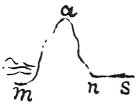
The Da Vinci Notebooks at sacred-texts.com
The water of the ocean cannot make its way from the bases to the tops of the mountains
which bound it, but only so much rises as the dryness of the mountain attracts. And if, on the contrary, the rain, which penetrates from the summit of the mountain to the base, which is the boundary of the sea, descends and softens the slope opposite to the said mountain and constantly draws the water, like a syphon 508 which pours through its longest side, it must be this which draws up the water of the sea; thus if s n were the surface of the sea, and the rain descends from the top of the mountain a to n on one side, and on the other sides it descends from a to m, without a doubt this would occur after the manner of distilling through felt, or as happens through the tubes called syphons 509 . And at all times the water which has softened the mountain, by the great rain which runs down the two opposite sides, would constantly attract the rain a n, on its longest side together with the water from the sea, if that side of the mountain a m were longer than the other a n; but this cannot be, because no part of the earth which is not submerged by the ocean can be lower than that ocean.
198:508 11: Cicognola, Syphon. See Vol. I, Pl. XXIV, No. 1.
198:509 17: Cicognola, Syphon. See Vol. I, Pl. XXIV, No. 1.